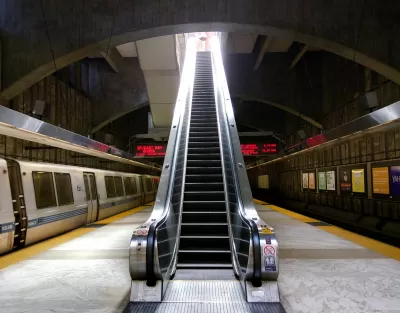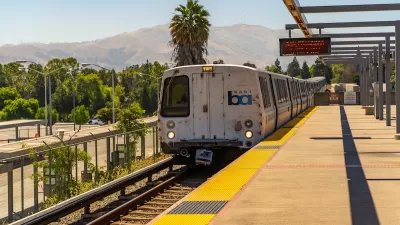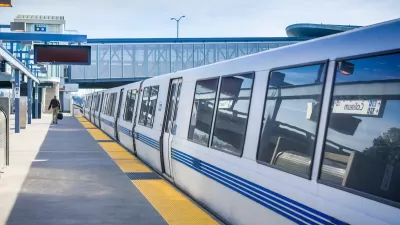Bay Area Rapid Transit, a hugely successful system pre-pandemic, is now struggling to close a massive projected budget gap, with no certain solutions on the table.

Once an agency with the nation’s highest farebox recovery ratio, San Francisco’s Bay Area Rapid Transit (BART) system now faces an uncertain future, writes Ricardo Cano in the San Francisco Chronicle.
With ridership remaining low, “In its worst-case scenario, BART would impose mass layoffs, close on weekends, shutter two of its five lines and nine of its 50 stations and run trains as infrequently as once per hour.” Even worse, “Those deep cuts, agency officials say, could lead to the demise of BART.” Cano outlines the system’s current state, noting that BART will run out of federal funding in January 2025, a situation much more severe for agencies like BART that rely heavily on fare revenue. While officials have proposed a variety of potential solutions, there is no long-term plan yet.
Cano points out that “A Bay Area without BART, however unimaginable, would further fragment public transit, worsen traffic congestion on highways and bridges, and erode the natural flow of a region so profoundly shaped by the rail system.”
BART General Manager Bob Powers says the agency has to change its revenue model. “Instead of relying mostly on fares, we must invert our funding formula to rely more heavily on subsidies and a sustainable source of revenue that recognizes ridership recovery will take years.” California transit agencies are asking for a state subsidy, while BART is pushing for a local ballot measure. But according to Cano, “Newsom’s January budget included $2 billion in cuts to transit projects with no subsidy, highlighting the challenges of securing a state bailout.”
FULL STORY: Could the Bay Area lose BART?

Planetizen Federal Action Tracker
A weekly monitor of how Trump’s orders and actions are impacting planners and planning in America.

Chicago’s Ghost Rails
Just beneath the surface of the modern city lie the remnants of its expansive early 20th-century streetcar system.

San Antonio and Austin are Fusing Into one Massive Megaregion
The region spanning the two central Texas cities is growing fast, posing challenges for local infrastructure and water supplies.

Since Zion's Shuttles Went Electric “The Smog is Gone”
Visitors to Zion National Park can enjoy the canyon via the nation’s first fully electric park shuttle system.

Trump Distributing DOT Safety Funds at 1/10 Rate of Biden
Funds for Safe Streets and other transportation safety and equity programs are being held up by administrative reviews and conflicts with the Trump administration’s priorities.

German Cities Subsidize Taxis for Women Amid Wave of Violence
Free or low-cost taxi rides can help women navigate cities more safely, but critics say the programs don't address the root causes of violence against women.
Urban Design for Planners 1: Software Tools
This six-course series explores essential urban design concepts using open source software and equips planners with the tools they need to participate fully in the urban design process.
Planning for Universal Design
Learn the tools for implementing Universal Design in planning regulations.
planning NEXT
Appalachian Highlands Housing Partners
Mpact (founded as Rail~Volution)
City of Camden Redevelopment Agency
City of Astoria
City of Portland
City of Laramie





























